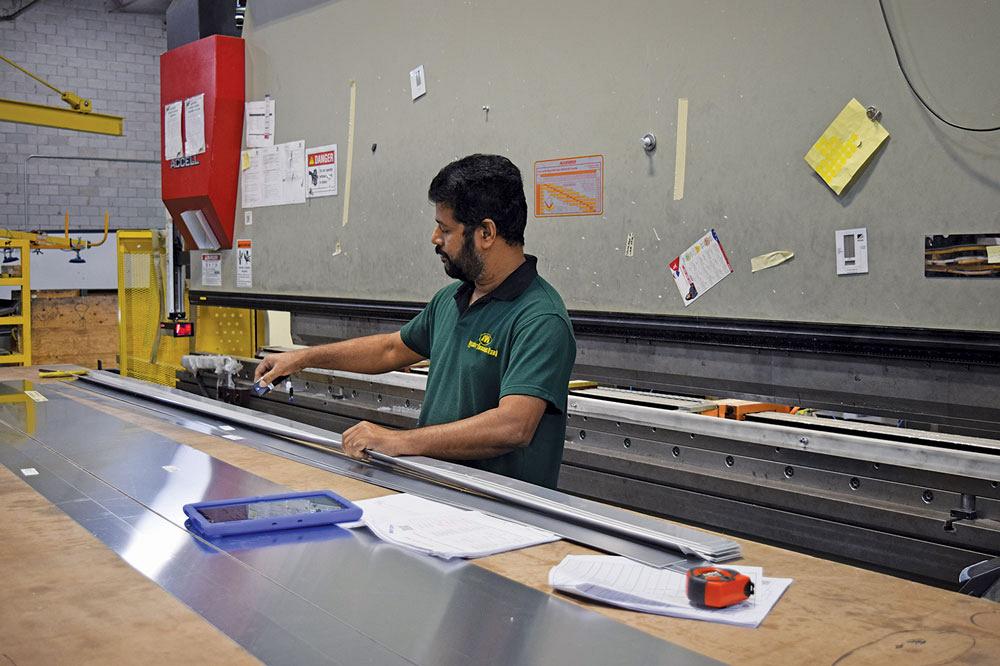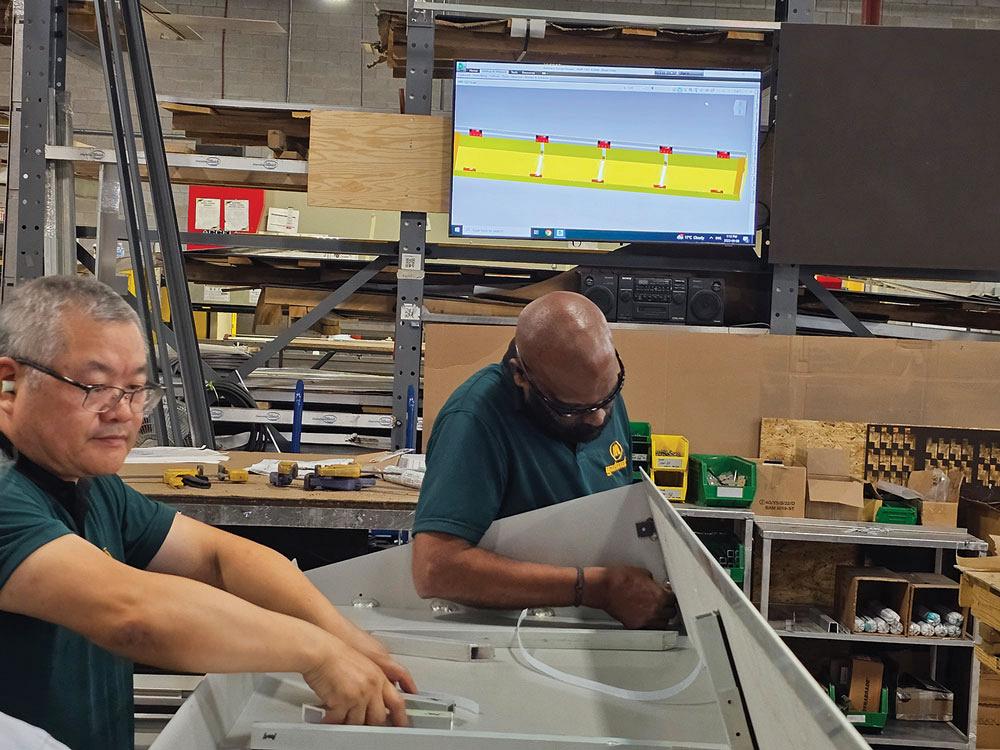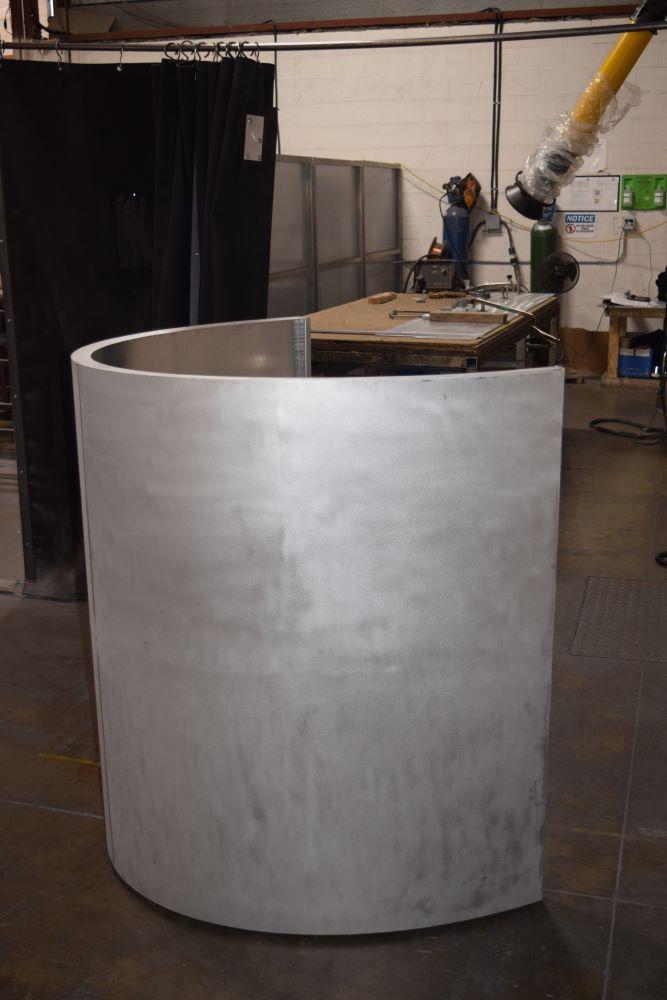Editor
- FMA
- The Fabricator
- FABTECH
- Canadian Metalworking
There’s a fabricating app for that
Yarlmetal changes its approach to workflow management by adopting a low-code software platform
- By Rob Colman and Tim Heston
- November 24, 2023
- Article
- Fabricating
Visit any fabricating shop and you’ll see any number of very advanced machines on the floor, from fibre lasers to CNC press brakes and automated welding operations. Shop floor workflow gets more precise and efficient all the time.
However, the related office software systems oftentimes can’t keep up. Faced with a paper trail overload, keeping track of everything from inventory to quality control can lessen the impact of all the advancements achieved on the shop floor.
Despite the data embedded in these advanced machines, some front offices are still looking at printouts of spreadsheets. Even when a shop has invested in enterprise resource planning (ERP), customer relationship management (CRM), manufacturing execution system (MES), or similar production monitoring and planning software, it’s not always easy to connect one system to another and have everyone play in the right sandbox together.
For years, the industry has used software platforms that work extraordinarily well, save for a few isolated cases—a unique process, an overlooked detail. And so fab shop managers manually export the data into a spreadsheet and develop yet another homegrown solution. The challenge is that large software systems weren’t really designed for the needs of smaller shops with lots of product numbers. Their hard and fast rules can be a daunting roadblock rather than a helping hand.
The big names in the industry have pivoted their models to meet the needs of job shops in the past few years, working on a model that better routes custom parts through a shop system, but such a system can still feel rigid and monolithic to shops that just want what they need when they need it—not all the bells and whistles that such systems inevitably come tied to.
Now there’s yet another alternative approach, the low-code app. Working like LEGO blocks, a low-code app creates an environment where companies can pick and choose the elements they want to integrate in a shop management system as and when they like.
Toronto-based Yarlmetal Fabrications is an early adopter of this type of technology.
Low-Code Lowdown
“More than any other market, job shops appreciate flexibility,” said Wayne Byrne, founder of Tangle, a low-code platform that allows users to build their own apps with a drag-and-drop interface. “I’ve been building low-code, drag-and-drop interfaces for 25 years, though they weren’t called ‘low code’ until the past few years or so.”
Until recently, low-code apps really focused on dashboards and communication tools. “They were still based on spreadsheets,” Byrne said, “though with a bit of analytics built in.”
Users can click apps together in various ways to create all sorts of custom applications, but they still need to use those LEGO blocks. This, Byrne said, “gets you about 80 per cent there. You have your solution, but you also have to manually fill out notes to describe the exceptions. It doesn’t handle every scenario.”

When it began its search for a new ERP system, Yarlmetal wanted to be able to barcode all of its parts to keep track of who is touching what piece. Shown is a team member scanning a part in preparation for a bending operation.
The latest low-code apps, Tangle included, still use those LEGO building blocks, but they also allow users to add their own code, effectively allowing them to create their own LEGO blocks to accommodate specific, often unique problems.
This overcomes the customization conundrum many fabricators face. So many platforms, ERP or otherwise, could be the perfect solution if they could just do … fill in the blank. A company might be tempted to ask for a software package to be customized, but that adds costs and complexity, not to mention the potential lack of support. Low-code apps bring shops that last mile without having to customize off-the-shelf software. This is exactly what Yarlmetal Fabrications was looking to achieve.
Yarlmetal’s Diversity Challenge
Yarlmetal was founded in 1990 and specializes in metal fab work for architectural applications, making such products as back pans, brake shapes, formed panels, insulated panels, and column covers. The company currently operates in a 50,000-sq.-ft. facility, with 50 people on the shop floor and 20 in the front office.
As the company has grown, its project diversity has also.
“Early in our history, we were doing work for window and glass businesses around the Greater Toronto Area,” said Dhimo Lad, general manager at Yarlmetal. “The variety of those jobs required us to maintain a large inventory of various materials, and also required short turnaround times. In the intervening years, however, as we’ve expanded our reach in Canada and into the U.S., the work has become both more sophisticated and varied, but we can manage our inventory more effectively because orders are larger.”
But working with larger customers also requires keeping a tighter control on quality and workflow, and quality is a cornerstone of Yarlmetal’s business.
“In the construction industry, quality and on-time delivery are hard to come by, so if you can prove yourself to your customers, it builds the strength of that relationship and keeps your good name in the market,” said Lad.
The ERP systems the company had used in the past just didn’t fit their requirements to make this happen seamlessly.
“We originally had a software developed in-house that we used for 10 years,” said Lad. “When we grew beyond that, we started using an ERP system supplied by one of the bigger vendors in the market. Before that, purchasing and inventory were managed using Excel-based spreadsheets. But we really needed to integrate all of that with our purchase orders and what materials were coming in and flowing out of the building.”
Tracking Accountability
Initially, over the course of a couple years, the ERP seemed to work effectively for the company. But eventually, like so many other companies, Yarlmetal wanted to push its capabilities.

The company has worked to become more efficient in other areas in concert with ERP advances, including adding a fibre laser to speed panel production.
“We wanted to be able to barcode all of our parts as they are being manufactured to keep track of who is touching what piece,” said Lad. “We had high-level visibility of our processes, but we couldn’t drill down to get accountability on the shop floor. What would happen is that a part might be sheared wrong. We would try to determine when the error was made. We'd run two shifts, and fingers would start to point. We needed more granular data so that we would know where the issue happened and how it could be remedied.”
What Lad wanted was a system in which each person would scan the part as they took over processing it – the part would receive its barcode as it came off the fibre laser, and thereafter everyone would scan the part as they began working on it.
The company’s ERP system couldn’t do this, so they started creating a workaround using Tangle. But when they saw how Tangle could operate, they decided to shift solely to that platform.
“It’s just so customizable,” said Lad. “I’m not a coder at all, and it was still easy for me to figure out and be able to do.
“Quality is a very big concern for us, so this system prompts each person at each station, ensuring they process the part correctly,” she continued. “For instance, if you are operating a shear, it will prompt you to enter your shear size and take a picture of the face of the piece. We are adding many more of these in-process quality checks like this. I’d much rather catch 1,000 mistakes within our shop floor and be able to remedy them than send one mistake to a customer.”
The barcoding system has helped track inventory effectively as well.
“During COVID, we experienced material variations that we had never seen before because our suppliers were likely sourcing from many new places due to the supply chain challenges at the time,” said Lad. “Because our oversight via our former ERP system was much higher level, it was difficult to keep track of what material was coming from which vendor. Now, our in-process checks scan material directly from the skid so that every part can be traced right back to that stock. Being able to customize our software this way is very helpful.”
Shipping Shortcut
Yarlmetal has been using Tangle for about eight months now and is already seeing positive results in certain areas—the front office and the shipping department.
The front office is getting better information, allowing them to make more effective decisions with respect to material supplies.
“One of the projects that we're currently working on is keeping track of our inventory cycle time and how long material is staying on the shelf,” said Lad. “We just recently took off half of our galvanized SKUs. We're not going to be ordering these anymore; based on our usage and tracking our usage, we're just going to order other sizes that we are actively using to just try it out, see how it works, and clear up a lot of floor space.”

Quality is a big concern for Yarlmetal, so the system prompts each person at each station, ensuring they process the part correctly. In the company’s assembly department, they show employees 3D work drawings on a screen above their department. Lad said it is easier to interpret the work processes when the part is visible in 3D rather than a 2D drawing.
In terms of shipping, having that barcode trail makes it much easier for employees to pack up orders.
“All of the packing list checks were previously done manually, which means it was easier for human error to lead to the wrong parts being packed in the wrong crate,” said Lad. “Given that these crates get delivered directly to company work sites, any errors can create serious downtime for our customers. Now, everything is scanned in and the packing slip is auto-generated. That was something our previous ERP system couldn’t do. It had very particular rules about packing slip generation that didn’t make sense for the way we had to ship project work – with often each part in a crate being unique to that order. It was very clunky; it felt like you were taking something very firm and trying to break it in. Instead, we now have a very lean approach that we can mold to our needs.”
Metrics and Maintenance
All quoting and purchase orders are generated via Tangle also, but there is much more Lad wants to build into the system as time allows. For instance, although work instructions are brought up when each person scans a part they are working on, the company hasn’t yet used this to transition to a paperless shop floor, although Lad considers this a possibility soon.
Initially, she is more focused on creating better dashboards for tracking all the metrics the system is gathering.
“We are in the midst of developing a simplified scheduling board that our shift managers can access,” she said. “Right now, we’re still using Excel for scheduling, but all of this data is in Tangle, so why not use it? At the very least, it will allow them to check schedule adherence on the floor.”
All of the company’s machines have been scanned into the app as well, so Lad plans to use the system as a tool for preventive maintenance checks.
“We will be able to put all of our service notes through the system and develop our purchase orders for that maintenance work through it also.”
Ultimately, she would also like to tie HR into the system. Staff already log themselves in, so a portal for employee records, quality control history, machine training, and attendance records makes sense.
Because it’s a system that you build piece by piece, however, Lad can focus on getting one or two blocks right before running with a larger rollout to avoid the risk of implementing too many pieces at once.
“All of these ideas of where we will go with this are in my head,” she said. “It’s great to have a place for me to actively build and make a lot of these concepts come to life.”

Working on projects as varied as theatres, office buildings, and airports, Yarlmetal needs to make sure crates get delivered directly to work sites without any errors. Using Tangle has made this easier to achieve for the shipping department. The barcode trail makes it much easier for employees to scan parts to pack orders. Here we see the Tom Patterson theatre in Stratford, Ont.
Being a custom shop may make process management complicated, but Lad insists it’s what has made Yarlmetal the success it is.
“You can’t really ship custom work overseas,” she noted. “It’s a challenge to successfully do this work, but it is also our opportunity.”
AI and the Low-Code App
AI might further help companies like Yarlmetal develop their low-code app infrastructures.
When ChatGPT burst onto the scene last year, many thought low-code apps might be doomed. If AI has the potential to write software from scratch, why do you need those LEGO building blocks that limit what low-code apps can accomplish?
“It turns out, AI is the low-code-app’s best friend,” Byrne said.
Today, most software programmers are using AI to accelerate development. “Now, why would you write a program from scratch? Let the AI at least get you started,” Byrne said.
In most situations, developers really can’t rely on AI to write every single line of code. Those working with low-code apps, however, can use AI to help write that last bit of code and provide users, fab shops included, with a highly customized solution.
Recently, Tangle added a ChatGPT interface that can write that last bit of code on a custom app. It can also help users solve complex problems like scheduling—not by clicking around a complex platform, but by literally talking to the AI.
“We’re now doing smart scheduling using AI,” Byrne said. “You tell ChatGPT what you’ve got going on, you tell it a rule set, and it gives you a suggested schedule.”
He emphasized that the scheduling technology itself isn’t new. The method used for this custom app happens to use the drum-buffer-rope methodology from the Theory of Constraints. The scheduler also still works with the data that it’s given—the run times, changeover times, and all the rest. As it always has, garbage-in, garbage-out still applies. If wasted activity isn’t captured, the system won’t see it.
The real innovation here is in the software interface. Configuring all of the parameters through a manual interface would be an arduous task. “The AI here is mostly a translator for humans,” Byrne explained. “It takes human logic and turns it into computer logic. So, you can tell it, ‘Schedule my work, but prioritize these particular jobs, and deprioritize these orders.’ The system will factor in that logic, and it will tell you why certain orders are scheduled the way they are.”
An Open Future
As a product, low-code platforms like Tangle are tough to pigeonhole. The idea is for these platforms to mutate into anything a fabricator or any other user needs them to be.
For instance, Tangle can work with existing ERP systems, scheduling systems, or anything else, and build low-code apps around them to create a complete solution. That’s precisely how Yarlmetal started on its journey with the tech. But as the company has shown, it can be used as a stand-alone system, offering the traditional functions of an ERP as well as quoting, scheduling, quality, production control, and customer-facing web portals (another addition that Yarlmetal hopes to introduce in the future to create yet more transparency with its clients).
Byrne added that the system can use what’s known as RPA, or robotic process automation. “If you’re trying to get information out of a system that doesn’t have an open API, you can make a bot that pretends to be a person.” Use cases vary, but in effect, RPA acts as an API when no API exists, allowing different legacy platforms to shake hands and get along. The key point is that shops now have new options in terms of how they approach their software rollouts. Even with existing ERP systems, low-code apps can be brought in to fill gaps and smooth the rough edges a shop might be struggling with. It’s all about having the right tool for the job.
Editor Robert Colman can be reached at rcolman@fmamfg.org. Contributing Editor Tim Heston can be reached at theston@fmamfg.org.
Tangle, www.tangle.io
Yarlmetal Fabrications Inc., yarlmetal.com
About the Authors

Rob Colman
1154 Warden Avenue
Toronto, M1R 0A1 Canada
905-235-0471
Robert Colman has worked as a writer and editor for more than 25 years, covering the needs of a variety of trades. He has been dedicated to the metalworking industry for the past 13 years, serving as editor for Metalworking Production & Purchasing (MP&P) and, since January 2016, the editor of Canadian Fabricating & Welding. He graduated with a B.A. degree from McGill University and a Master’s degree from UBC.

Tim Heston
2135 Point Blvd
Elgin, IL 60123
815-381-1314
subscribe now


Keep up to date with the latest news, events, and technology for all things metal from our pair of monthly magazines written specifically for Canadian manufacturers!
Start Your Free Subscription- Industry Events
Automate 2024
- May 6 - 9, 2024
- Chicago, IL
ANCA Open House
- May 7 - 8, 2024
- Wixom, MI
17th annual Joint Open House
- May 8 - 9, 2024
- Oakville and Mississauga, ON Canada
MME Saskatoon
- May 28, 2024
- Saskatoon, SK Canada
CME's Health & Safety Symposium for Manufacturers
- May 29, 2024
- Mississauga, ON Canada























